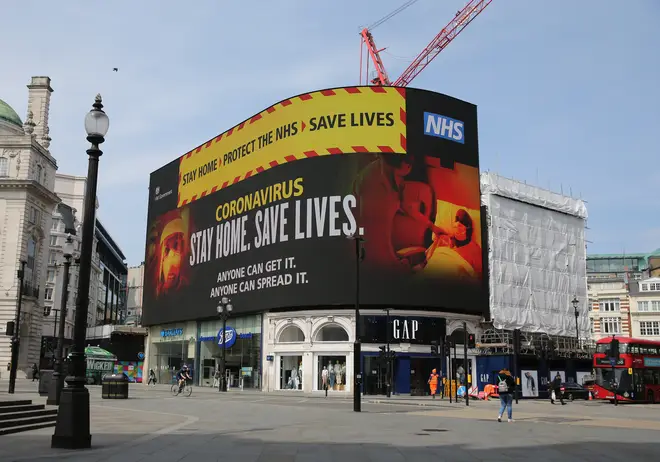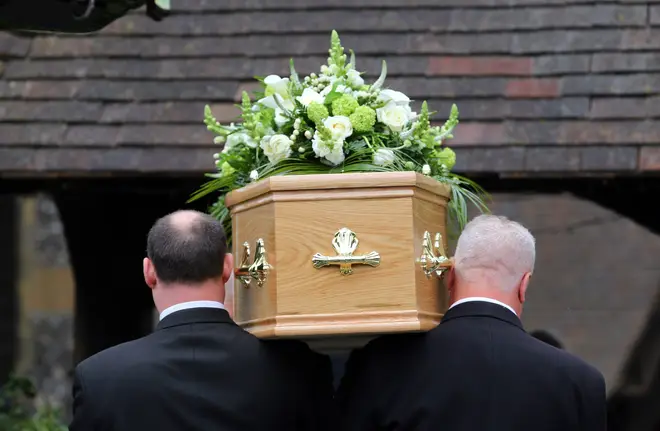
Rachel Johnson 7pm - 10pm
30 October 2020, 18:43 | Updated: 31 October 2020, 06:41

Deaths from Covid-19 are feared to exceed "reasonable worst case planning levels" in the coming weeks, with more than 85,000 people expected to lose their lives to the virus by April.
Senior scientists are now calling for a second national lockdown to curb the rapid spread of the disease, as new figures revealed around 570,000 people per week are becoming infected across England alone.
The Office for National Statistics (ONS) infection survey found cases "continued to rise steeply" in the week ending October 23, with an estimated 568,100 people in households becoming infected.
The Prime Minister has repeatedly resisted calls for their to be a national lockdown, and the Government's top scientific advisors now believe it is "too late" for a two-week national circuit-breaker to have enough of an effect.
Instead, they believe a longer national lockdown is needed to drive the reproduction number, or R value, of the virus below one.
All parts of England are on course to eventually end up in Tier 3 restrictions, they believe, while deaths could potentially hit 500 per day within weeks.

Government scientists are also confident that more than 50,000 new cases of coronavirus are now occurring every day in England.
It comes as official documents released by the Government show that a Scientific Advisory Group for Emergencies (Sage) meeting on October 8 said the number of infections and hospital admissions is "exceeding the reasonable worst case scenario (RWCS) planning levels at this time".
Read more: Coronavirus deaths rise by 274 as 24,405 new infections are recorded
The document said the number of deaths was also "highly likely to exceed reasonable worst case planning levels" within the next two weeks.
Sage documents leaked to The Spectator this week showed an RWCS of 85,000 Covid-19 deaths until the end of March, with more than 500 deaths a day for 90 days at the peak.
The Sage document of October 8 said a continued rise in hospital admissions means that "if there are no decisive interventions, continued growth would have the potential to overwhelm the NHS, including the continued delivery of non-Covid treatments".

Jolyon Maugham on evidence PPE deals were awarded to Cabinet contacts
A separate Scientific Pandemic Influenza Group on Modelling, Operational sub-group (SPI-M-O) consensus statement dated October 14 said "combined estimates from six SPI-M-O models suggest there are between 43,000 and 74,000 new infections per day in England".
In September, the Government's chief scientific adviser Sir Patrick Vallance warned that without action, the UK could see 50,000 coronavirus cases a day by mid-October and more than 200 daily deaths.
Read more: Police break up 'unlawful' protest outside French embassy in London following Nice attack
Over the last week, deaths have averaged 230 a day while the latest ONS data suggests more than 50,000 cases a day.
The new ONS figures, based on 609,777 swab tests taken whether people have symptoms or not, show the highest rates are in the North West and Yorkshire and the Humber.
Rates also remain high in the North East, but the ONS said these have now levelled off and "there is now a larger gap with the other two northern regions".
Analysis by the PA news agency of the data shows that the estimated percentage of people in north-east England testing positive went from 0.57% for the period September 12 to 25 to 1.41% for the period of September 26 to October 9.
But the rate of increase appears to be levelling off, with the latest figure being 1.43% for the period October 10 to 23.

Students disregard rules as Nottingham moves into Tier 3
In contrast, the North West has jumped from 1.57% for September 26 to October 9 to 2.47% for the period October 10 to 23.
The lowest rates are in the South East, South West and eastern England, while there has been growth in all age groups over the past two weeks.
Sage said on Friday the reproduction number, or R value, of coronavirus transmission for the whole of the UK is between 1.1 and 1.3 - representing the situation over the last few weeks.
Last week, the group said the R number was slightly higher at between 1.2 and 1.4.
Earlier, Foreign Secretary Dominic Raab said the Government is "striving" to avoid issuing blanket restrictions nationwide as he insisted targeted measures could slow the growth in cases.
Asked whether ministers had been given a "very, very bleak" presentation by scientists on Thursday about rising cases and the future death toll, Mr Raab told BBC Radio 4's Today programme: "We are very careful to protect the integrity of the discussions and the information we have, but we do think the situation is serious.
"Having said that, we're confident we've got the right measures and framework in place - which is not to have a blanket approach - with the target measures, both (in terms of) restrictions but also financial support on the areas where the uptick is the highest.
"We have seen, since we adopted that approach, a decrease in the rate of growth, but clearly there is still an uptick in the virus.
"We are battling a second wave, and we're going to do everything we can in a targeted and focused way to repress and bring those numbers back down."
Elsewhere, Sheffield City Region mayor Dan Jarvis said on Friday that the number of Covid-19 patients in South Yorkshire hospitals is nearly double the peak of the first wave of the virus.
Mr Jarvis tweeted: "There are now 700 people in hospital with the virus, approaching double the peak of 414 during the first wave of the pandemic in the spring."
One in five people in England will be living under the toughest coronavirus restrictions from Monday when West Yorkshire moves into Tier 3, while 58% of the population will be living under either Tier 2 or 3 measures.
Nottinghamshire entered Tier 3 restrictions on Friday, with groups of young people taking to the streets in fancy dress on Thursday evening just before the measures came in.
In the market square in Nottingham, people were seen drinking alcohol in groups after pubs closed and chanting near police vehicles, while youngsters posed for photographs dressed as minions from the film Despicable Me.
Elsewhere, the West Midlands is expected to be moved up to Tier 3 shortly, with local authority sources saying the "very high" alert level could be imposed "by the end of next week or the start of the following week".
And in Hartlepool, Labour MP Mike Hill said the Tees Valley was heading towards Tier 3, adding: "Just finished a meeting with minister. Local leaders are thrashing out a package for the Tees Valley Region right now."
More than a dozen regions will move from the lowest to the middle tier of restrictions on Saturday.
These include the East Riding of Yorkshire, Kingston-Upon-Hull, North East Lincolnshire, North Lincolnshire, Dudley, Staffordshire, Telford, the Wrekin, Amber Valley, Bolsover, Derbyshire Dales, Derby City, South Derbyshire, the whole of High Peak, Charnwood, Luton and Oxford.